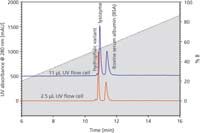Influence of UHPLC Detector Cell Volume on Reversed-Phase Separations of Proteins
The Application Notebook
Tosoh Bioscience
Reversed-phase chromatography (RPC) is the most frequently used chromatographic mode when analysing small molecular weight compounds. Nevertheless, various applications for the separation of larger biomolecules, such as proteins, are also based on RPC. Conventional stationary phases with 80–140 Å pore sizes are not suited for the analysis of large intact proteins, as the large analytes are not able to access the surface area within the pores. A new silica-based wide-pore butyl/C4 phase — TSKgel Protein C4-300 — completes the existing range of TSKgel protein analysis columns.
TSKgel Protein C4-300 columns are available in 2 and 4.6 mm inner diameter and 5, 10 and 15 cm column length. The pore size of 300 Å is ideal for the separation of proteins. The particle size of 3 µm and the optimized ligand density and alkyl length result in better protein and peptide resolution compared to other leading RP-C4 HPLC phases. Latest surface modification technology and TMS end-capping reduce undesirable secondary interactions and peak tailing. The new columns were used for protein analysis on an UHPLC system equipped with standard or semi-micro detector cells.
Experimental
Hen egg white lysozyme and bovine serum albumin (BSA) were separated on a TSKgel Protein C4-300 column. The UHPLC UV detector was originally equipped with an 11 µL standard flow cell, which was then exchanged to a 2.5 µL semi-micro flow cell.
Column: TSKgel Protein C4-300 (2 mm i.d. × 5 cm L)
Mobile phases: A: ACN/H2O/TFA (10/90/0.05); B: ACN/H2O/ TFA (80/20/0.05)
Gradient: 0–100% B in 15 min
Flow rate: 0.2 mL/min
Detection: UV @ 215 nm
Injection volume: 1 µL
Sample: BSA and lysozyme 1 g/L each
Results
Figure 1 shows the separation of the two standard proteins lysozyme and BSA on a TSKgel Protein C4-300 2 mm i.d. column using a standard 11 µL flow cell connected to a UHPLC system. The two components can be resolved by a factor of 2.28. A significant increase in resolution between the two peaks could be achieved when applying the 2.5 µL detector flow cell to the same system and column, resulting in a resolution factor of 2.88.

Figure 1: Separation of lysozyme and bovine serum albumin (BSA) on TSKgel Protein C4-300 (2 mm i.d. à 5 cm L) with a standard UV detector flow cell (blue, 11 µL volume) and a semi-micro UV detector flow cell (red, 2.5 µL volume).
Conclusion
The 3 µm particles of TSKgel Protein C4-300 offer good resolution of the two proteins and a hydrophilic variant on a standard UHPLC system. Exchanging the UV flow cell for a semi-micro 2.5 µL flow cell led to an increase in resolution by approximately 25%. This proves that properly equipped UHPLC systems can further enhance the performance of the new C4 material. This is only related to the choice of the ideal detector cell and the reduced overall dead volume; the high power limits of such systems are not relevant for this application. Hence, the new TSKgel Protein C4300 reversedphase columns can be applied in all types of HPLC systems, no matter whether conventional HPLC or UHPLC.
Tosoh Bioscience GmbH
Zettachring 6, 70567 Stuttgart, Germany
tel. +49 (0)71113257 0 fax +49(0)71113257 0
Email: info.tbg@tosoh.com Website : www.tosohbioscience.com


.png&w=3840&q=75)

.png&w=3840&q=75)



.png&w=3840&q=75)



.png&w=3840&q=75)








